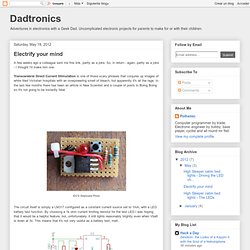

How to Enable Safe Mode in Windows 7. Computers are complex and delicate machines, with millions of lines of computer code manipulating millions of transistors just to bring you to your desktop!

It's not surprising, then, that things can sometimes go terribly wrong while you're updating your BIOS, downloading new drivers, or just surfing the Web. But that doesn't mean you have to throw away this incredibly complex (and sometimes incredibly expensive) device and replace it with a new one. When a computer goes haywire and the operating system has trouble starting or reaching the desktop, the problem often involves misconfigured recently installed software or drivers (special software that communicates with your hardware).
The installation may go smoothly--but when you reboot the system, you start getting errors. If you can't get to the desktop, you can't uninstall the bad program or drivers, and you may feel trapped. To get to Safe Mode, take these steps: Www.trans-cranial.com/local/manuals/cortical_functions_ref_v1_0_pdf.pdf. Transcranial direct current stimulation: State of the art 2008. Received 29 April 2008; received in revised form 2 June 2008; accepted 6 June 2008. published online 03 July 2008.

Summary Effects of weak electrical currents on brain and neuronal function were first described decades ago. Recently, DC polarization of the brain was reintroduced as a noninvasive technique to alter cortical activity in humans. Beyond this, transcranial direct current stimulation (tDCS) of different cortical areas has been shown, in various studies, to result in modifications of perceptual, cognitive, and behavioral functions. Useage. Electrode Positioning and Montage in Transcranial Direct Current Stimulation... Transcranial direct current stimulation (tDCS) is an established technique to modulate cortical excitability1,2.

It has been used as an investigative tool in neuroscience due to its effects on cortical plasticity, easy operation, and safe profile. One area that tDCS has been showing encouraging results is pain alleviation 3-5. Date Published: 5/23/2011, Issue 51; doi: 10.3791/2744 Keywords: Neuroscience, Issue 51, Transcranial direct current stimulation, pain, chronic pain, noninvasive brain stimulation, neuromodulation DaSilva, A. Transcranial direct current stimulation (tDCS) is a technique that has been intensively investigated in the past decade as this method offers a non-invasive and safe alternative to change cortical excitability2. 1.
Check if you have all materials needed (Table 1, Figure 1). User Tutorial:EEG Measurement Setup - BCI2000 Wiki. This page describes the physical setup required for EEG measurements.

EEG utilizes metal electrodes attached to a human subject's scalp, measuring tiny electrical potentials which reflect the brain's electrical activity. Although setting up amplifier and electrodes appears simple and straightforward, a successful, good quality EEG recording requires attention to not-so obvious details, and some practice. Electrodes An EEG amplifier measures voltage differences between points on the scalp. This implies that each channel is connected to two electrodes. EEG electrodes are small metal plates that are attached to the scalp using a conducting electrode gel.
While Sn electrodes have the advantage of being cheap, they introduce a large amount of low-frequency noise ("drifting") below 1Hz. Important but often neglected: Using electrodes made from different materials in the same recording will result in DC voltage offsets between electrodes, due to electrochemical contact potentials. International 10-20 System of Electrode Placement. EEG. 10-20 electrode placement system, EEG. Google Image Result for. Project:brain_hacking:tdcs.jpg [brmlab] tDCS. Open Source Hardware TDCS. I’ve been having a lot of fun experimenting with Transcranial Direct Current Stimulation (TDCS) in the last two weeks.
There is a lot of information available on the Internet about TDCS. There are many hobbyist circuit diagrams available (e.g. 1 2 3) and at least two commercial designs that have been published by Focus Headband v1 and GoFlow. There’s not much missing from the hobbyist TDCS discussion, except perhaps collaboration and a bit of polish. I am not particularly qualified to help with either, but I’ll try anyway. TDCS: Brain Zapping for Fun and Profit I’ve created a simple TDCS circuit diagram around the LM334Z. You’ll notice that it is very similar to the GoFlow schematic linked above. The whole project (including all source files) was created with gEDA and friends and is published on github under a Creative Commons Attribution 3.0 License. Want to learn about circuit design or make changes to the board? Tdcs/bom.txt at master · nocko/tdcs. Img/kickstarter-images/public-schematic.pdf. Electrify your mind. A few weeks ago a colleague sent me this link, partly as a joke.

So, in return - again, partly as a joke - I thought I'd make him one. Transcerebral Direct Current Stimulation is one of those scary phrases that conjures up images of white tiled Victorian hospitals with an overpowering smell of bleach, but apparently it's all the rage. In the last few months there has been an article in New Scientist and a couple of posts to Boing Boing so it's not going to be instantly fatal. The circuit itself is simply a LM317 configured as a constant current source set to 1mA, with a LED battery test function. By choosing a 1k ohm current limiting resistor for the test LED I was hoping that it would be a helpful feature, but, unfortunately, it still lights reasonably brightly even when Vbatt is down at 3v. Www.foc.us/open/focus-v1-schematic.pdf.